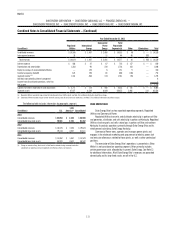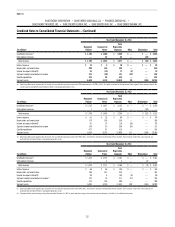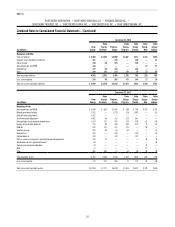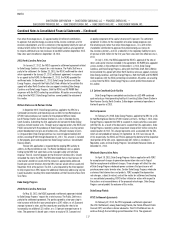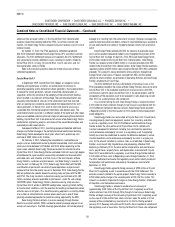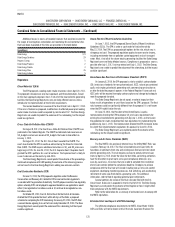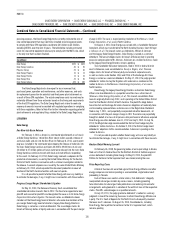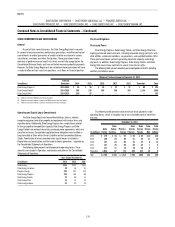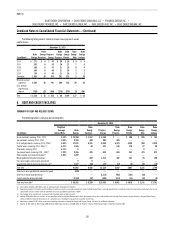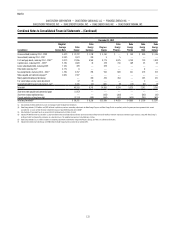Duke Energy 2013 Annual Report Download - page 139
Download and view the complete annual report
Please find page 139 of the 2013 Duke Energy annual report below. You can navigate through the pages in the report by either clicking on the pages listed below, or by using the keyword search tool below to find specific information within the annual report.
121
PART II
DUKE ENERGY CORPORATION • DUKE ENERGY CAROLINAS, LLC • PROGRESS ENERGY, INC. •
DUKE ENERGY PROGRESS, INC. • DUKE ENERGY FLORIDA, INC. • DUKE ENERGY OHIO, INC. • DUKE ENERGY INDIANA, INC.
Combined Notes to Consolidated Financial Statements – (Continued)
the optimal corporate structure is an ongoing evaluation of factors, such as
tax considerations, that may change between now and the transfer date. In
conjunction with the transfer, Duke Energy Ohio’s capital structure will be
restructured to reect appropriate debt and equity ratios for its regulated
operations. The transfer could instead be accomplished within a wholly owned
nonregulated subsidiary of Duke Energy Ohio depending on nal tax structuring
analysis. The FERC approved the application on September 5, 2012. Duke
Energy Ohio agreed to transfer the legacy coal-red and combustion gas turbine
assets on or before December 31, 2014.
Regional Transmission Organization (RTO) Realignment
Duke Energy Ohio including Duke Energy Kentucky, transferred control of
its transmission assets from MISO to PJM, effective December 31, 2011.
On December 22, 2010, the KPSC approved Duke Energy Kentucky’s
request to effect the RTO realignment, subject to a commitment not to seek
double-recovery in a future rate case of the transmission expansion fees that
may be charged by MISO and PJM in the same period or overlapping periods.
On May 25, 2011, the PUCO approved a settlement between Duke Energy
Ohio, Ohio Energy Group, The Ofce of Ohio Consumers’ Counsel and the
PUCO Staff related to Duke Energy Ohio’s recovery of certain costs of the RTO
realignment via a non-bypassable rider. Duke Energy Ohio is allowed to recover
all MISO Transmission Expansion Project (MTEP) costs, including but not limited
to Multi-Value Project (MVP) costs, directly or indirectly charged to Duke Energy
Ohio retail customers. Duke Energy Ohio will not recover any portion of the MISO
exit obligation, PJM integration fees, or internal costs associated with the RTO
realignment, and the rst $121 million of PJM transmission expansion costs
from Ohio retail customers. Duke Energy Ohio also agreed to vigorously defend
against any charges for MVP projects from MISO.
Upon its exit from MISO on December 31, 2011, Duke Energy Ohio
recorded a liability for its exit obligation and share of MTEP costs, excluding
MVP. This liability was recorded within Other in Current liabilities and Other
in Deferred credits and other liabilities on Duke Energy Ohio’s Consolidated
Balance Sheets.
The following table provides a reconciliation of the beginning and ending
balance of Duke Energy Ohio’s recorded obligations related to its withdrawal
from MISO.
(in millions)
Balance at
December 31,
2012
Provision /
Adjustments
Cash
Reductions
Balance at
December 31,
2013(a)
Duke Energy Ohio $97 $ 2 $ (4) $ 95
(a) As of December 31, 2013, $74 million is recorded as a Regulatory asset on Duke Energy Ohio’s
Consolidated Balance Sheets.
MVP. MISO approved 17 MVP proposals prior to Duke Energy Ohio’s exit
from MISO on December 31, 2011. Construction of these projects is expected
to continue through 2020. Costs of these projects, including operating and
maintenance costs, property and income taxes, depreciation and an allowed
return, are allocated and billed to MISO transmission owners.
On December 29, 2011, MISO led a tariff with the FERC providing
for the allocation of MVP costs to a withdrawing owner based on monthly
energy usage. The FERC set for hearing (i) whether MISO’s proposed cost
allocation methodology to transmission owners who withdrew from MISO prior
to January 1, 2012 is consistent with the tariff at the time of their withdrawal
from MISO, and, (ii) if not, what amount of, and methodology for calculating
any MVP cost responsibility should be. On July 16, 2013, a FERC Administrative
Law Judge (ALJ) issued an initial decision. Under this initial decision, Duke
Energy Ohio would be liable for MVP costs. Duke Energy Ohio led exceptions
to the initial decision, requesting the FERC overturn the ALJ’s decision. After
reviewing the initial decision, along with all exceptions and responses led by
the parties, the FERC will issue a nal decision. Duke Energy Ohio fully intends
to appeal to the federal court of appeals if the FERC afrms the ALJ’s decision.
Duke Energy Ohio cannot predict the outcome of these proceedings.
In 2012, MISO estimated Duke Energy Ohio’s MVP obligation over the
period from 2012 to 2071 at $2.7 billion, on an undiscounted basis. The
estimated obligation is subject to great uncertainty including the ultimate cost
of the projects, the annual costs of O&M, taxes and return over the project lives
and the allocation to Duke Energy Ohio.
Duke Energy Indiana
Edwardsport IGCC Plant
On November 20, 2007, the IURC granted Duke Energy Indiana a
Certicate of Public Convenience and Necessity (CPCN) for the construction
of a 618 MW IGCC power plant at Duke Energy Indiana’s existing Edwardsport
Generating Station in Knox County, Indiana with a cost estimate of $1.985 billion
assuming timely recovery of nancing costs related to the project. On
January 25, 2008, Duke Energy Indiana received the nal air permit from
the Indiana Department of Environmental Management. The Citizens Action
Coalition of Indiana, Inc., Sierra Club, Inc., Save the Valley, Inc., and Valley
Watch, Inc., all intervenors in the CPCN proceeding (collectively, the Joint
Intervenors), appealed the air permit. A settlement related to the air permit was
reached on August 30, 2013. The air permit was not impacted by the provisions
of the settlement.
Duke Energy Indiana experienced design modications, quantity increases
and scope growth above what was anticipated from the preliminary engineering
design, which increased capital costs for the project. As a result, the projected
cost estimate increased throughout construction of the project and various
revised estimates were led with the IURC. In October 2012, Duke Energy
Indiana revised its latest projected cost estimate to $3.15 billion (excluding
AFUDC).
On December 27, 2012, the IURC approved a settlement agreement
(2012 Edwardsport settlement) related to the cost increase for the construction
of the project, including subdockets before the IURC related to the project. The
Ofce of Utility Consumer Counselor (OUCC), the Duke Energy Indiana Industrial
Group and Nucor Steel-Indiana were parties to the settlement. This settlement
agreement resolved all then pending regulatory issues related to the project. The
settlement agreement, as approved, capped costs to be reected in customer
rates at $2.595 billion, including estimated AFUDC through June 30, 2012.
Duke Energy Indiana is allowed to recover AFUDC after June 30, 2012, until
customer rates are revised, with such recovery decreasing to 85 percent on
AFUDC accrued after November 30, 2012. Duke Energy Indiana also agreed not
to request a retail electric base rate increase prior to March 2013, with rates in
effect no earlier than April 1, 2014.
The IURC modied the 2012 Edwardsport settlement as previously agreed
to by the parties to (i) require Duke Energy Indiana to credit customers for cost
control incentive payments the IURC found to be unwarranted as a result of
delays that arose from project cost overruns and (ii) provide that if Duke Energy
Indiana should recover more than the project costs absorbed by Duke Energy’s
shareholders through litigation, any surplus must be returned to the Duke Energy
Indiana’s ratepayers.


